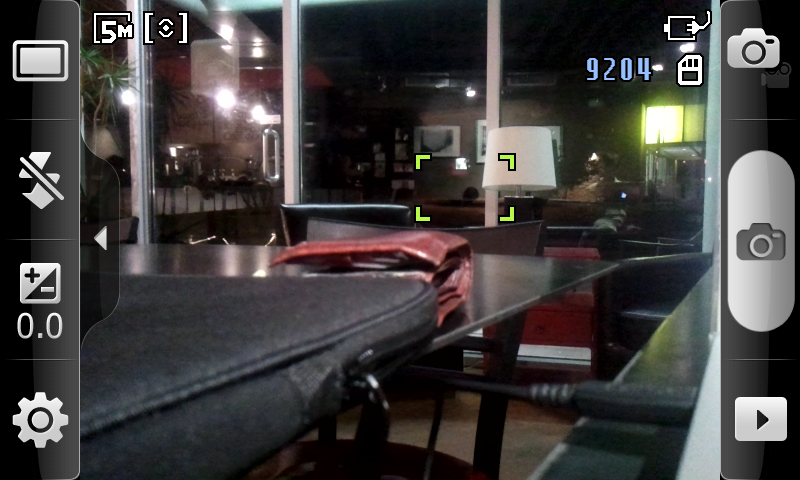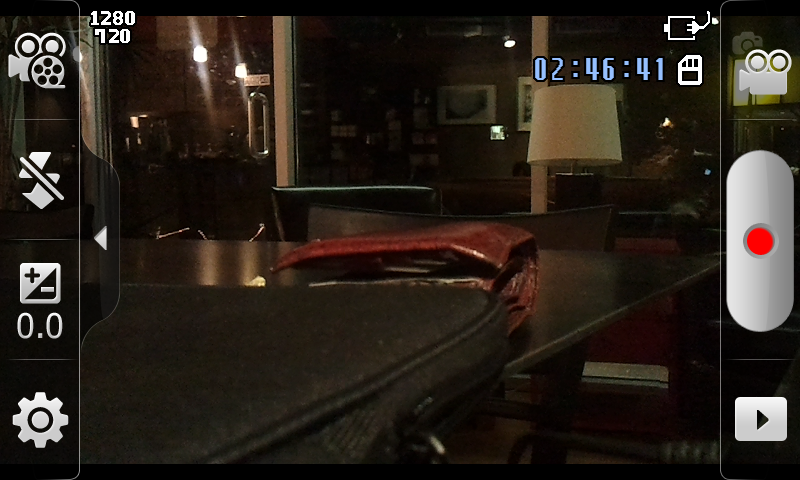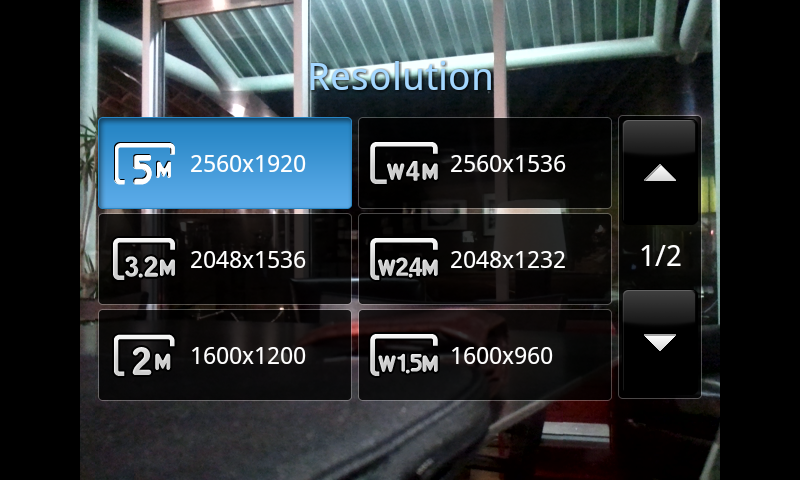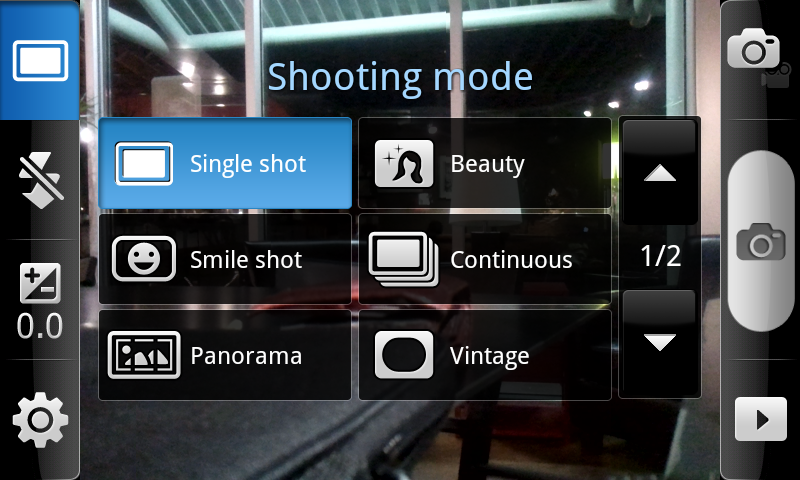Samsung Fascinate Review: Verizon's Galaxy S Smartphone
by Brian Klug on October 5, 2010 12:01 AM EST- Posted in
- Smartphones
- Samsung
- Galaxy S
- Fascinate
- Mobile
Camera
The Fascinate packs a 5 megapixel camera with one LED flash. There's no front facing camera like the Epic 4G, however. Camera launch is relatively speedy, at 2.8 seconds from tapping the application icon to getting a live preview. Successive captures are moderately fast, at around 2 seconds between capture and another preview.
Just like the Epic (and probably the other Galaxy S phones) the camera UI has a simple mode where everything goes away but very basic information and the control buttons. Like Anand said, the camera application repurposes buttons. Power becomes a lock button that stops input, volume controls digital zoom.
Tapping on the left brings up a small drawer with more settings - shooting modes, flash, exposure, and more settings. There's an outdoor visibility button in settings which increases brightness and contrast for composure outside, among all the usual resolution and quality options. Samsung has done a nice job providing lots of control if you want, or abstracting it away if you're inclined.
For a full tour of those settings, check out the gallery below:
Tap to focus is implemented on the Fascinate, including LED illuminated focus when it's dark. There's a confirmation sound when focus is reached as well.
The only nitpick I have about the Fascinate's camera UI is that the icons don't rotate when you switch into portrait mode from landscape. As a result, I was misled many times that images would be recorded rotated 90 degrees. There's rotation support in the captured image's EXIF header for sure, it just doesn't give any feedback in the camera application that acknowledges rotation.
The images captured on the Fascinate are impressive. There's very little distortion or edge falloff, and saturation is about right. There also isn't very much chromatic noise.
The photos taken in the lightbox with the lights on are a bit pink, however detail and dynamic range are quite good. The single LED flash on the Fascinate is actually surprisingly powerful - the photo taken with the lights off is overexposed, which is unfortunate. Apparently the Fascinate doesn't have extremely good short distance metering. This is one case where I wish my lightbox setup was a bit different, since the tradeoff is that photos taken at normal distances are very nicely illuminated. Even better, the camera application focuses with the LED on when you're in the dark, so you have good odds of actually getting focus - something the default Android camera app still doesn't do.
As usual, I've taken photos with the Fascinate in my usual bench locations, and in the lightbox. I've updated things a bit as well with new shots from the Nexus One. A number of readers pointed out that my Nexus One seems to have below average camera performance. I'm inclined to agree that performance seemed below average, and tried numerous times to improve it. I finally got HTC to replace my Nexus One, and reshot everything again, including the video tests. I'd say that the camera performance is largely unchanged between my replacement Nexus One and the old one - the Nexus One camera just isn't as impressive as other 5 MP cameras.
Video on the Fascinate is 720P in H.264 with AAC audio. I measured an average bitrate of 11.89 megabits/s in our bench video at the usual location. Quality is decent but it seems like there's a bit of edge blur and loss of high spatial frequency possibly due to noise reduction. Luckily, you can shoot video with the Fascinate's bright LED flash enabled in the dark. As per usual, compare for yourself with the videos below:
Samsung Fascinate
Motorola Droid 2
BlackBerry Torch 9800
Motorola Droid X
HTC EVO 4G
Nexus One (redux)
iPhone 4
HTC Droid Incredible
Motorola Droid
Nokia N900






































73 Comments
View All Comments
netmasterjohn - Tuesday, October 5, 2010 - link
How come Fascinate & Nexus One video are the same?dman - Tuesday, October 5, 2010 - link
I appreciate the testing methodology including the GPS fix times. I had an ATT Tilt (HTC 8925) which was notoriously slow in getting locked in. I got into the habit of starting the GPS app as soon as I'd get outdoors so that by the time I'd get to my vehicle it'd only have a couple minutes left. That and a few other workarounds. Sad that they still have issues these days...Chadder007 - Tuesday, October 5, 2010 - link
My Droid X came with a 16GB card, not 8.chemist1 - Tuesday, October 5, 2010 - link
Brian: Thanks for your reply. I'm pleased to hear you're trying to move in that direction. The idea of playing with CDMA voice codecs is intriguing -- I didn't occur to me that the audio quality (AQ) of smart phones could actually be user-modifiable at the software level. Though much of what determines AQ is hardware—the quality of the speaker in the earpiece, the circuitry upstream of it (and at the headphone jack output), the quality of the microphone (for those on the receiving end of your call), etc.More broadly, I like your general program of trying to put all areas that are now subjective onto a more objective footing. The problem with doing that for AQ is that it’s tricky. Often something can measure well, yet sound mediocre—which typically means that the measurements being used aren’t the right ones (for instance, maybe you’re measuring distortion, but the real problem is a phase error); or, alternately, perhaps the measurements aren’t being weighted properly. One solution is to supplement measurements with purely subjective, yet controlled, observations (a listening panel). You could also evaluate audio under compromised conditions by checking word recognition accuracy (but the danger here is that what might help accuracy under poor conditions—say, a boosted upper midrange—might make the phone fatiguingly harsh to listen to under normal conditions). Beyond that, I’d just reiterate what I said in my first post—I’d advise bringing in someone with a trained ear and/or lots of audio testing experience (if that's possible). [You can test for a trained ear by seeing if he/she can distinguish between different codecs in a single-blind test; or, alternately, perhaps you know, say, a recording engineer or a good classical pianist.]
Also, if you would, please ask Anand to read the Heijligers link I posted in my last comment, before he next tests iPods! [And you or he might wish to test the Redwine modification available for the 4G–5.5G iPods (http://redwineaudio.com/products/imod), to hear for yourselves what difference improved output circuitry can make in PMP AQ.]
Ranari - Tuesday, October 5, 2010 - link
*NOTE TO AUTHOR*Verizon and Microsoft have an advertising contract between each other, which is why you see Bing plastered all over the Samsung Fascinate. Businesses can control mobile ads in the Bing search engine using the Microsoft Adcenter. Mind you, this is over the Verizon network, but you can also see a few Bing mobile ads on m.bing.com, or if you download the Bing app on your smartphone. If you want a more Google experience, the other carriers will probably be your thing, but I find it to be more of an extension of the Android OS.
Personally, I think Bing has a pretty awesome mobile platform.
Aside from that, the review perfectly matches up with my thoughts about my Samsung Vibrant (T-Mobile).
-The Super AMOLED is absolutely gorgeous.
-The GPU is overkill, and I like it that way.
-Performance is great
-Battery life is mediocre
-And the GPS sucks bizalls
Cheers!
silverblue - Wednesday, October 6, 2010 - link
Sorry, didn't mean to be picky. :)anaxagoras1986 - Wednesday, October 6, 2010 - link
I'm not sure how the Galaxy is clearly better. It has a better GPU which is great, but only if you can use it. I don't play games so GPU performance is less important to me.Real-world performance with an Incredible (all of which are 2.2 now, why are you still testing or showing 2.1 results?) is close to the Nexus One 2.2 and HTC Evo 2,2. The charts show the 2.2 phones with a substantial performance advantage over the Galaxy.
So how is the Galaxy clearly better?
Doppleganger77 - Wednesday, October 6, 2010 - link
Even applying just the lag fix (fixes file system) to a 2.1 Galaxy S dramatically increases performance. For example, in the Quadrant benchmark I routinely achieve over 2200 points compared to about 800 for a standard Galaxy S. The Nexus One 2.2+ by comparison achieves around 1300 points. By applying a one click solution this phone can fly.ezinner - Thursday, October 7, 2010 - link
Arghh! I love the Galaxy S phones, but why oh why can't they put phone function buttons on the phone? Remember that this is still a phone and the most common functions are answer and end call!Jumpman23 - Saturday, October 9, 2010 - link
I always thought the iPhone ran at 1 GHz. So is 800MHz a typo or...